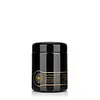What's inside
What's inside
 Key Ingredients
Key Ingredients

 Benefits
Benefits

 Concerns
Concerns

 Ingredients Side-by-side
Ingredients Side-by-side

Kaolin
AbrasiveGlycerin
HumectantWater
Skin ConditioningBentonite
AbsorbentTrehalose
Humectant1,2-Hexanediol
Skin ConditioningSea Water
HumectantSea Salt
AbrasiveAllantoin
Skin ConditioningPanthenol
Skin ConditioningLactobacillus
Skin ConditioningCaprylyl Glycol
EmollientCellulose Gum
Emulsion StabilisingEthylhexylglycerin
Skin ConditioningButylene Glycol
HumectantTocopherol
AntioxidantXanthan Gum
EmulsifyingSolum Fullonum
AbsorbentTheobroma Cacao Fruit Powder
Skin ConditioningMoroccan Lava Clay
AbrasiveCinnamomum Zeylanicum Bark Powder
Skin ConditioningMyristica Fragrans Powder
MaskingSea Salt
AbrasiveAscorbic Acid
AntioxidantCharcoal Powder
AbrasiveSodium Bicarbonate
AbrasiveEugenia Caryophyllus Flower Bud Powder
Skin ConditioningVanilla Planifolia Seed Powder
AbrasiveLavandula Angustifolia Flower Powder
MaskingAlthaea Officinalis Root
Skin ConditioningBoswellia Carterii Bark Powder
ExfoliatingCapsicum Annuum Fruit Powder
Skin ConditioningKaolin
AbrasiveCentella Asiatica Leaf/Stem Powder
Curcuma Longa Root Powder
Skin ConditioningSilica
AbrasiveCinnamal
PerfumingSolum Fullonum, Theobroma Cacao Fruit Powder, Moroccan Lava Clay, Cinnamomum Zeylanicum Bark Powder, Myristica Fragrans Powder, Sea Salt, Ascorbic Acid, Charcoal Powder, Sodium Bicarbonate, Eugenia Caryophyllus Flower Bud Powder, Vanilla Planifolia Seed Powder, Lavandula Angustifolia Flower Powder, Althaea Officinalis Root, Boswellia Carterii Bark Powder, Capsicum Annuum Fruit Powder, Kaolin, Centella Asiatica Leaf/Stem Powder, Curcuma Longa Root Powder, Silica, Cinnamal
 Reviews
Reviews

Alternatives
Ingredients Explained
These ingredients are found in both products.
Ingredients higher up in an ingredient list are typically present in a larger amount.
Kaolin is a clay. It is used for oil control and to help minimize pores. Like other clays, kaolin has the ability to absorb excess sebum or oil. This can help clean out pores and mattify the skin.
Some types of kaolin may have exfoliating properties. When water is added to kaolin, it becomes a paste with small abrasive particles.
Most kaolin is a white color, but may be pink/orange/red depending on where it comes from.
The name 'kaolin' comes from a Chinese village named 'Gaoling'. Kaolin clay comes from rocks rich in kaolinite. Kaolinite, the mineral, has a silicate layered structure. Kaolinite is formed from chemical weathering of aluminum siilicate minerals.
Besides skincare, kaolin is commonly used to make glossy paper, in ceramics, toothpaste, and as medicine to soothe stomach issues.
Learn more about KaolinSea salt has abrasive or exfoliation properties. It can sensitize and dry out the skin.